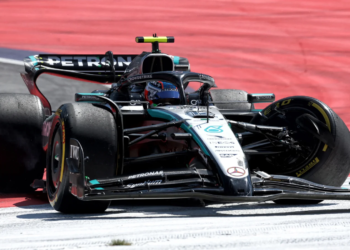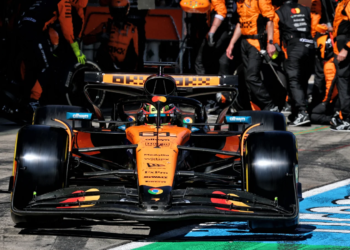Ferrari is trying to solve its straight-line speed problems through various technical changes, as it attempts to make the SF1000 more competitive, with one of its greatest weaknesses being its deficit on the straights.
At the Power Unit level, Ferrari is re-designing the engine in view of 2021, to try to recover the gap to Mercedes with the advent of the new rules on the double fuel-flow meter, and on the limitations of additive oils.
On an aerodynamic level, Ferrari is forced to compete with fairly low downforce levels. As we saw at last weekend’s British Grand Prix, and then again this weekend for the 70th Anniversary event, Ferrari has used a rear-wing similar to what teams would run at Spa-Francorchamps, with a reduced rope and an almost neutral main plane (see below).

To avoid unloading the aerodynamics too much, and therefore losing speed when cornering, Ferrari could also intervene on the set-up of the SF1000, initially designed with a very evident rake set-up, almost like that of the Red Bull RB16.
The rake set-up consists of a rear that is much higher off the ground than the front. This solution was pioneered by Red Bull which has run an extreme rake set-up for many seasons to great success, but it’s a concept some teams are thinking about moving away from in future and instead following Mercedes’ more neutral approach.
A high-rake set-up aims to increase the effect of the rear-diffuser by speeding up the airflow as it expands from a narrow area at the front to an open and wider rear. It’s a concept many teams have adopted included Mercedes, although to a far lesser extent.
In the below illustration you can see a direct comparison between the various set-ups of the three top teams, Ferrari, Mercedes and Red Bull.

McLaren have already confirmed they are looking at a lower rake concept for 2021, so could Ferrari follow suit much sooner with its SF1000 as it grapples with having to run lower downforce – and therefore reduced cornering speeds – to benefit its top speed?


![Lando Norris and Oscar Piastri [McLaren] celebrate their 1-2 finish at the 2025 F1 Austrian GP](https://www.motorsportweek.com/wp-content/uploads/2025/06/Lando-Norris-Oscar-Piastri-McLaren-F1-2025-1-120x86.webp)

![Lando Norris and Oscar Piastri [McLaren] celebrate their 1-2 finish at the 2025 F1 Austrian GP](https://www.motorsportweek.com/wp-content/uploads/2025/06/Lando-Norris-Oscar-Piastri-McLaren-F1-2025-1-350x250.webp)


![Lando Norris and Oscar Piastri [McLaren] celebrate their 1-2 finish at the 2025 F1 Austrian GP](https://www.motorsportweek.com/wp-content/uploads/2025/06/Lando-Norris-Oscar-Piastri-McLaren-F1-2025-1-360x180.webp)

